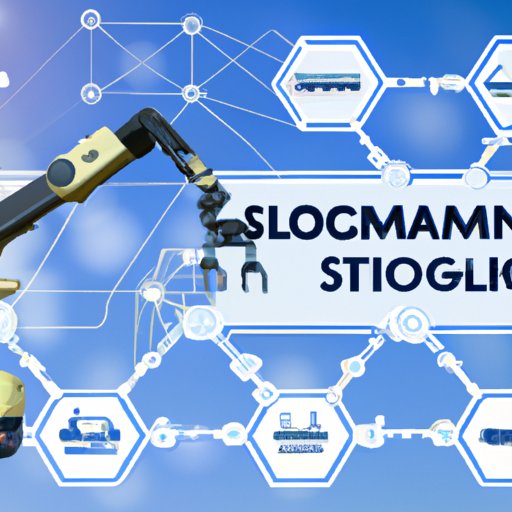Introduction
Logistics and supply chain are two related concepts that are often used interchangeably but have distinct meanings. Logistics is a specialized field of business focused on the efficient movement of goods from point A to point B. Supply chain management, on the other hand, is a broader concept that encompasses all aspects of the business from sourcing raw materials to delivering the finished product to end customers. In this article, we’ll explore the differences between logistics and supply chain management and discuss how they interact to enable businesses to succeed.

Exploring the Difference Between Logistics and Supply Chain Management
Logistics is the process of moving goods from one place to another. It includes activities such as transportation, warehousing, inventory management, packaging, and order fulfillment. Logistics involves planning, organizing, and controlling the physical flow of goods and services from the supplier to the customer. The goal of logistics is to ensure that products reach their destination on time and in good condition.
Supply chain management is a broader concept than logistics. It involves the entire process of creating and delivering products to customers. This includes activities such as sourcing raw materials, production, distribution, and customer service. Supply chain management focuses on optimizing the flow of goods and services throughout the entire organization, from start to finish.
According to Professor Chris Caplice of MIT’s Center for Transportation & Logistics, “Logistics is part of a larger system of activities known as the supply chain. Logistics is the ‘nuts and bolts’ of the supply chain—the tangible activities such as transportation, warehousing, and inventory management. Supply chain management, on the other hand, is the coordination of these activities to optimize the overall performance of the system.”
The Role of Logistics and Supply Chain in Business Success
Logistics plays an important role in the success of a business. Efficient logistics can help reduce costs, improve customer service, and increase profits. Logistics is also crucial for meeting customer expectations and ensuring that products arrive on time and in good condition.
Supply chain management is also essential for business success. It helps organizations manage their resources more effectively and maximize profits. By optimizing the flow of goods and services, supply chain management enables businesses to reduce costs, improve customer service, and gain a competitive edge.

An Overview of Logistics and Supply Chain Strategies
Logistics strategies focus on optimizing the movement of goods from one place to another. These strategies include selecting the right transportation mode, choosing the most cost-effective routes, and developing effective inventory management systems. Logistics strategies also involve finding ways to reduce costs and improve efficiency.
Supply chain strategies are designed to optimize the entire process of creating and delivering products to customers. These strategies involve finding ways to reduce costs, improve customer service, and increase profits. Supply chain strategies also involve identifying potential risks and developing plans to mitigate them.
Tips for Streamlining Logistics and Supply Chain Processes
There are several steps that businesses can take to streamline their logistics and supply chain processes. For example, businesses can reduce costs by outsourcing certain activities, such as warehousing and transportation. They can also improve efficiency by automating certain processes, such as order fulfillment and inventory management. Additionally, businesses can enhance customer service by improving communication with suppliers and customers.

Automating Logistics and Supply Chain Operations
Automating certain logistics and supply chain operations can help businesses reduce costs and improve efficiency. Automation can be used to streamline processes such as order processing, inventory management, and transportation. Automation can also help businesses track shipments, monitor delivery times, and identify potential problems.
According to a study conducted by the Aberdeen Group, “Organizations that automate their supply chain processes see an average reduction in operating costs of 17%, an average reduction in lead times of 25%, and an average improvement in customer satisfaction of 14%.”
Analyzing the Benefits of Logistics and Supply Chain Integration
Integrating logistics and supply chain operations can help businesses reduce costs, improve efficiency, and enhance customer service. Integrated operations provide businesses with better visibility into their operations, allowing them to identify potential issues and take corrective action quickly. Additionally, integrated operations enable businesses to make better decisions based on real-time data.

Understanding How Logistics and Supply Chain Interact and Influence Each Other
Logistics and supply chain interact and influence each other in a variety of ways. Logistics can affect the flow of goods and services throughout the supply chain. For example, if there are delays in the transportation of goods, it can result in delays in the production process. Similarly, supply chain can affect logistics. For example, if there is a shortage of raw materials, it can result in delays in the transportation of goods.
Logistics and supply chain can be linked together to create an integrated system. This integration can help businesses reduce costs, improve efficiency, and enhance customer service. Businesses can achieve these benefits by sharing information between departments, streamlining processes, and leveraging technology.
Conclusion
Logistics and supply chain are two related but distinct concepts. Logistics is focused on the efficient movement of goods from point A to point B, while supply chain management is focused on the entire process of creating and delivering products to customers. Logistics and supply chain can interact and influence each other, and integrating these two functions can help businesses reduce costs, improve efficiency, and enhance customer service.
(Note: Is this article not meeting your expectations? Do you have knowledge or insights to share? Unlock new opportunities and expand your reach by joining our authors team. Click Registration to join us and share your expertise with our readers.)
